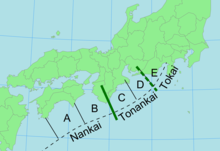This article relies largely or entirely on a single source. (April 2024) |

The Nankai earthquakes (南海地震, Nankai jishin) are major megathrust earthquakes that affect the Nankaidō (Southern Sea Circuit) region of Japan, west of the Tōnankai region (Southeastern Sea) and Tōkai region (Eastern Sea), and are caused by ruptures in the Nankai zone of the Nankai megathrust, specifically segments A and/or B. They occur with a return period of 100 to 200 years, and there is a high probability of one in the 21st century,[1] as the most recent was the 1946 Nankaidō earthquake. These have high destructive potential, and thus are a focus of earthquake preparation.These are a class of Nankai megathrust earthquakes, frequently occurring in combination with, or following, a rupture of segments C and/or D (Tōnankai zone, yielding Tōnankai earthquakes) and sometimes segment E (Tōkai zone, yielding Tōkai earthquakes). They are also known as Nankaidō earthquakes (南海道地震, Nankaidō jishin).
- ^ Fukushima, Yo; Nishikawa, Tomoaki; Kano, Yasuyuki (2023-01-10). "High probability of successive occurrence of Nankai megathrust earthquakes". Scientific Reports. 13 (1): 63. doi:10.1038/s41598-022-26455-w. hdl:2433/278851. ISSN 2045-2322.